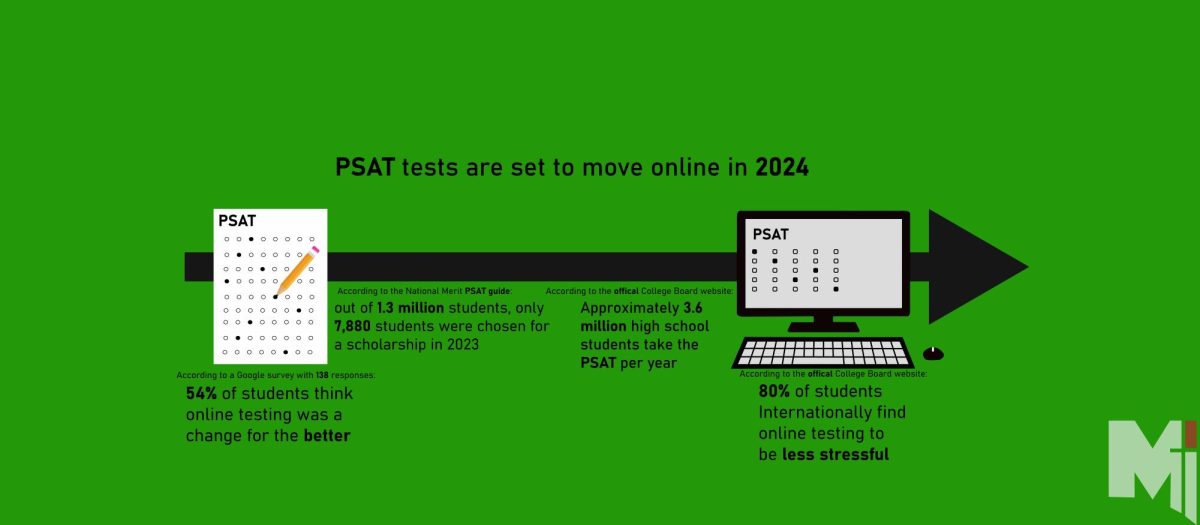A digital revolution over the past decade has turned life progressively more technology-based, and even standardized tests are adapting to this age too.
The new digital PSAT has surfaced this fall, which staff hopes to be a productive change for the school.
“This will be the first time that we’re offering it (digitally) for the PSAT,” guidance counselor in charge of the PSAT Dan Meara said. “I think in the long run, it’s probably going to be beneficial to students.”
The PSAT is a standardized test provided to sophomores and juniors by College Board said to earn a cumulative score that, depending on how well a student performs, can result in merit scholarships and recognition. College Board converted its product from a business standpoint for both consumer convenience and advantages.
On Oct. 10, the two administrators and counselors worked side by side to have the testing day run smoothly for both standardized tests. While having the tests together was beneficial for the school, there were other perks that came from the digital transition as well.
Being able to take the test on computers created a more efficient testing experience. According to sophomore Brady Beaver, one of the students who participated in the PSAT, students in his class appreciated this comfort.
“It was easier to go back and answer questions, and you still had a scratch piece of paper to write things down so everything was right there,” Beaver said. “On paper tests, you have to write on the test itself, so being online made it a lot simpler.”
College Board shared its intentions with the electronic transition on its website.
“Going digital allows us to offer much more flexibility in terms of when, where and how often the SAT is given,” the College Board wrote. “So we’re taking full advantage of what it means to deliver an assessment digitally.”
In previous years, students took this test on a regular school day. This conflicted with class times and caused stress for both the students and standardized testing counselors, Amy Carman and Dan Meara.
“Before with the tests being during a school day, it was hard to shut down the bells and for those kids to miss three classes and so now they don’t have to worry about that,” said Carman, who coordinates the PreACT.
While students did not take the physical PSAT last fall, they performed on the PreACT in page-dense packets. The PreACT is currently still in paper booklets, but Carman said that ACT will pilot its first digital test with 5,000 students attending in December. By having these tests digital, Carman said it can help the environment.
“Since we don’t have to mail the textbooks back, there’s less waste of paper,” Carman said. “We’re seeing in society as a whole that we’re moving away from paper, and we’re trying to become less dependent on it. This would be a representation of that.”
The PSAT testing packets approximately contained four pieces of paper per packet with an estimated 2,800 pieces of paper used throughout the school (based on average class size to packets ratio), according to Carman.
According to freshman Josephine Astor, student’s familiarity with devices has made them comfortable in digital environments, making online testing a simple switch for the young generations.
“We are used to this kind of testing since we have grown up with technology, such as computers,” Astor said. “So I feel like it should be easier than paper.”
While the PSAT was not available to freshmen like Astor this fall, she has had similar experiences with previous standardized testing like Beaver. The two both leaned towards online versus traditional testing because of the ease it added to their experiences.
With time condensation, efficiency and environmental factors playing into the digital transition of testing, there are still potential risks that come with the modification.
“The stresses of a digital test are questions like, ‘Is the internet working?’” Meara said. “What if kids get booted out? Things along those lines that cannot be predicted are our biggest concern.”
To combat these uncertainties, the students tested in designated rooms suited to accommodating the best internet performance across the building.
Meara said that he thinks the change will be a good outcome for students in the long term and advises both students and parents to embrace rather than fear a swap.
“We want them to do the best they can, and I think this is the evolution,” Meara said. “I think more and more tests are going to be offered online, and students are going to have more opportunities that way.”
With scores still pending, it is unclear if results vary with years prior.
“We’re excited to have the opportunity for students here to take the digital PSAT,” Meara said. “We hope that they do well and that we have some students qualify for National Merit because that’s a good showcase of student ability. We wish them the best of luck and a great future ahead.”















